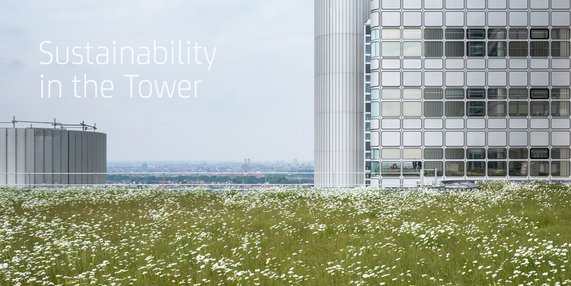
Ground-breaking sustainability concept
By resolutely embracing renewable energy and efficient use of resources, the HypoVereinsbank is continuously reducing its ecological footprint.
The approach of resource-saving and efficiency-enhancing measures is reflected in the renovation of the HVB-Tower, which as HypoVereinsbank’s largest building was also responsible for its highest resource consumption – and accordingly, significant savings potential. Thanks to forward-looking planning, more than 30 years after its creation the HVB-Tower is a ‘green building’ and in excellent shape for the future.
Sophisticated sustainability concept
To significantly reduce energy consumption from the status quo, the requirements for the building shell, the interior design and the technical systems in particular were analysed and coordinated to the high requirements of contemporary sustainability certifications.
Based on this sustainable, integrated planning, which also takes into account user comfort, conservation requirements and energy-efficient building operation, a sustainability concept was developed for the HVB-Tower. Its key features included:
- Use of groundwater for heating and cooling
- Highly efficient heat recovery
- Multifunctional façade with natural ventilation by means of openable windows
- Implementation of an ecological building materials concept
- Energy-efficient lighting
- Use of rainwater
The projected CO2 savings after refurbishment is more than 50 percent for the heating energy and more than 25 percent for the electricity supply.
Heating and cooling with geothermal energy
The HVB-Tower is temperature-controlled by heating/cooling ceilings that are powered by the geothermal plant. In winter, the extracted groundwater is heated using heat exchangers. In summer, cooling is carried out directly using the groundwater. The proportion of geothermal energy used in the HVB-Tower’s climate control is over 50 percent for heating and almost 40 percent for cooling. In addition, heat is supplied by the Stadtwerke München district heating system and cooling from the existing chillers.
Natural ventilation of the new office environment
A central ventilation system with highly efficient rotation heat recovery adjusts the amount of air necessary for the supply of fresh air according to demand. People can also use windows to ventilate the space. Due to the draughts that occur in the higher storeys of the tower, this option represented a particular technical challenge.
Energy and the façade
The listed existing façade was replaced with a new, multi-layered and multi-functional box window façade that does not alter the external appearance in the slightest. The inner shell consists of openable 3-fold sunscreen glazing behind laminated glass with a special reflective film between the panes, which restores the look of the original façade. Vents in the frame element allow for natural ventilation of the offices.
The 6,000 light metal parapet elements of the former façade were cleaned and reused in situ. The heat transfer coefficient of the new façade is greater than 1.0 W/m² K, which translates to excellent insulation properties.
Sunscreens and energy-efficient lighting
To exclude the need for increased cooling energy when the rooms heat up on sunny days, the glazing was optimally coordinated with the intelligent sun protection control system. This makes it possible to maximise the use of daylight without being subjected to glare. Daylight sensors manage the optimal lighting with artificial light (LED) to ensure a consistent brightness in the room as well as outstanding workstation quality.
Using rainwater to save water
Rainwater is collected on a green roof connected to a rainwater cistern and used for irrigating all the planted areas. Special water-saving taps were used in all areas.
Ecological construction materials concept
In choosing each material, particular emphasis was placed on regional sourcing, a high percentage of recycled content and compliance with limits on formaldehyde and volatile organic compounds. Furthermore, only certified wood was used. The strict implementation of the materials concept ensured that only products that meet the strict requirements were used on the construction site.
About 90 percent of the resulting rubble and construction waste was recycled.

